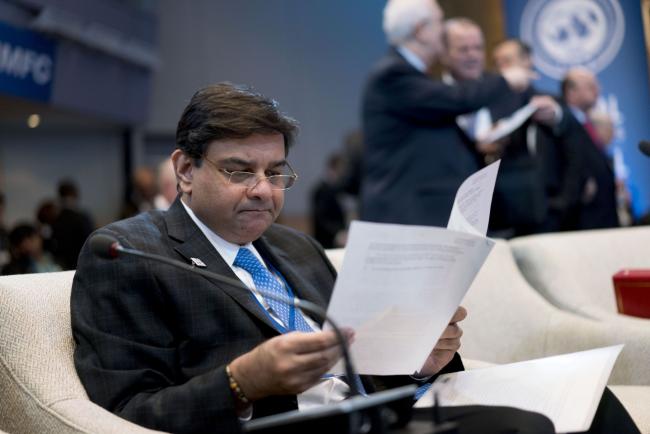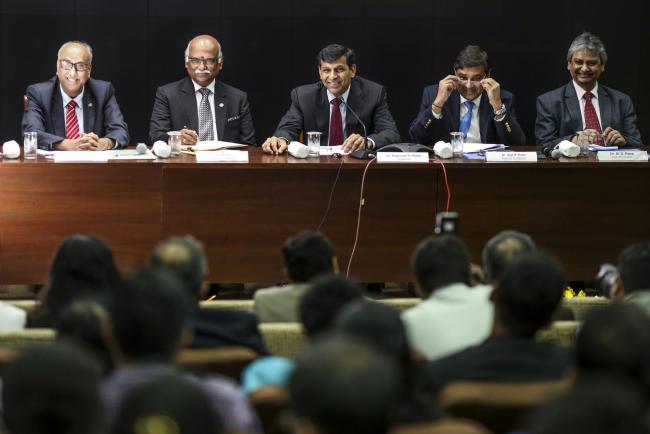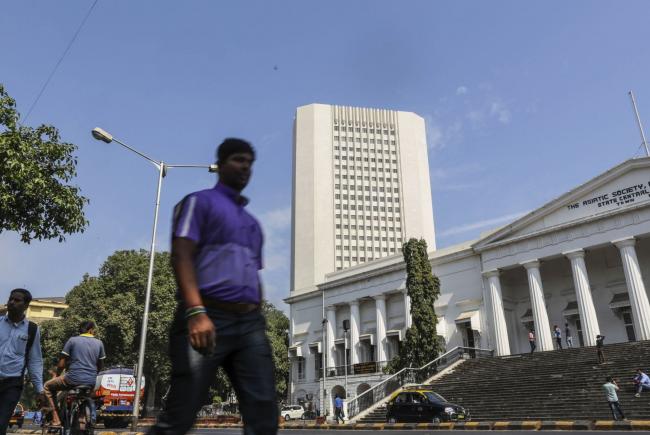(Bloomberg) -- Explore what’s moving the global economy in the new season of the Stephanomics podcast. Subscribe via Apple Podcast, Spotify or Pocket Cast.
Soon after taking over as India’s central bank governor almost a year ago, Shaktikanta Das decorated his 18th floor office overlooking the Arabian Sea with two statues of Lord Jagannath, a form of the Hindu god Vishnu.
Revered in Das’s native Odisha state, Jagannath is depicted with round, lidless eyes that are always watching over the welfare of devotees. It’s an appropriate adornment.
Das, overseeing what was until recently the world’s fastest-growing major economy, has worked tirelessly to restore relations with the government after a bitter public spat led his predecessor Urjit Patel to quit. Colleagues say Das usually tucks papers under his arms at the end of the work day to continue plugging away from home.
He’s paid a hefty dividend to the finance ministry, swung into stimulus mode and eased up on bank lending restrictions -- all of which Patel resisted in the face of government pressure. But there’s still much to do: the economy is losing steam on many fronts, the banking sector remains saddled with one of the world’s worst bad-debt loads and the government’s fiscal targets are slipping by the day.
Insiders say Das has turned around the mood in the bank’s Mumbai headquarters with an affable, plain-spoken approach. As one official said: He listens to everyone and then sticks to his own decision.
Among the RBI rank and file, the more academically-decorated predecessors of Patel and Raghuram Rajan were considered outsiders due to their long stints in American academia. Long-timers were put offside as in-house talent was often bypassed in senior appointments. Not with Das: in the job posting for a deputy in-charge of monetary policy, at least 25 years of government experience within India tops the priority list among requirements for the role.
Rajan and Patel were contrasting personalities -- Rajan the rockstar of global central banking and Patel reclusive both inside and outside the bank. Silver-haired Das strikes a balance. He has his own Twitter account and is more open to the media, giving interviews to local and foreign media including Bloomberg News. But he hasn’t taken to the global stage in the way Rajan did, such as when he led criticism of the Federal Reserve in 2014 for not taking into account the spillovers of its policies on emerging markets.
Das’s communication skills have helped improve the relationship with the government. The two sides no longer spar in public and instead resolve issues internally, finance ministry officials said. A recent example being the central bank’s reservations toward the finance ministry’s proposal for what would have been India’s first overseas sovereign bond issue. The proposal, which also met with opposition from within Prime Minister Narendra Modi’s own party, has been frozen.
The Reserve Bank of India has an out-sized role in the nation’s economy, making central bank-government friction a feature of policy making in the nation. Das is responsible for monetary policy, an exchange rate that’s near historic lows, supervising banks that carry one of the world’s biggest bad-debt loads, and selling bonds the government relies on to fund its yawning deficits. Most major central banks have only one or two of those duties.
“Some of the functions that the RBI juggles with are in conflict,” said Amartya Lahiri, Royal Bank Professor of Economics at the University of British Columbia, who was recruited during Patel’s time to lead the RBI’s in-house think tank. “This isn’t ideal if one has to build a credible and independent institution.”
It was a battle over independence that led to Patel’s early departure on Dec. 10. The cerebral and introverted Yale University-trained economist had sought to continue his predecessor Rajan’s efforts to clean up the nation’s financial sector by tightening wasteful lending by state banks and was keen to keep the RBI’s balance sheet as robust as possible in case of crisis. But as the economy slowed through 2018 and with a general election looming, Modi’s government pressed the RBI to loosen up lending restrictions to boost growth and to transfer surplus funds at the central bank.
Das, appointed on Dec. 11 for a three-year term, set about changing course almost immediately. In one of his first decisions announced in early January, he instructed banks to restructure stressed loans given to small and medium-scale enterprises, thus breaking from a five-year-old policy of eschewing corporate debt overhauls. That was quickly followed up by lifting lending restrictions on three state-run banks.
In February, in his first meeting of the six-member monetary policy committee that he chairs, Das along with three other members voted for a 25 basis point interest-rate cut. And in a sharp reversal from October last year, when the MPC led by Patel had taken rate cuts off the table, Das opened the door for more reductions and said reviving growth was the main priority of the inflation-targeting central bank. He’s cut five times this year, by a cumulative 135 basis points.
A test of Das’s ability to keep the government onside now presents itself given inflation has climbed back above the central bank’s medium-term target of 4%. The consumer price index bottomed out at 2% in January and was 4.6% in October. Despite the price revival, economists expect Das to stay in easing mode, and see the benchmark interest rate falling to 4.9% by the end of March 2020.
Das also heeded the government’s call for higher dividends, paying a record $24 billion to government coffers in August. But the RBI’s pockets aren’t infinite and at some stage in the future Das may have to stare down any further requests for bumper payouts.
Das is also in-charge of the exchange rate, and its management has in the past angered government officials and the export lobby, which complain about the rupee’s competitiveness. Das, like Patel, has reiterated the oft-repeated central bank approach that India’s exchange rate is market-driven and the RBI has no target in mind.
It’s the RBI’s role as regulator of the country’s banking system that creates the most potential for conflict with the government, because about 60% of the business is controlled by state-run banks. They are owned by the government and the RBI has limited supervision and legal powers to bring about changes in management to these banks, unlike the privately-owned ones where it holds more sway. That creates an uneven playing field leading to question marks over the efficacy of the central bank independence in regulating banks.
On Saturday, Das described the lack of strict corporate governance in state-run banks as the “elephant in the room,” and blamed it for elevated levels of non-performing assets, capital shortfalls, frauds and inadequate risk management.
Patel’s RBI was criticized for keeping financial conditions tight and failing to detect lapses in shadow lenders and banks on time. A large shadow bank failed last year, an event that triggered a chain of defaults in the financial sector and saw shadow banks withdraw from the lending space. Consumption took a beating as hundreds of millions of poorer Indians rely on shadow finance, dragging economic growth to a six-year low of 5%.
Das has assured investors that another large-scale collapse won’t be allowed in the shadow-banking sector. The RBI has asked for greater powers over the so-called non-bank finance companies, something the government has granted.
What really sets the RBI apart from many of its counterparts, especially in the west, is its role as the investment banker to the government. That creates potential for priorities in one realm to influence other areas of its mandate. For instance, the RBI may be encouraged to keep interest rates low to help manage the government’s borrowing, even though inflation targets might come under threat, risking macro-economic and financial stability.
Under Patel, the central bank bought a bulk of the federal government’s borrowing requirements, although he warned about the crowding out effect on private investments from large public debt issuance. Under Das, the borrowing program has proceeded without much of a hitch so far, helped by easier financial conditions.
“Whether the management of the public debt should be with the RBI is a controversial issue,” said C. Rangarajan, governor at the RBI from 1992 to 1997. “We had recommended if the government wanted to take over they can do it. The only issue is there is the need for certain expertise in handling this and RBI by virtue of performing this function over a long time has the experience.”
Das has so far managed to juggle these multiple and often conflicting roles. But as the economy slows, bad debt piles up and the budget deficit target goes out the window, it’ll be a tough to keep all the balls in the air.
“Being a full-service central bank with a broad span of responsibilities gives the RBI more power and influence, but also makes it more subject to the pulls of political tides,” said Eswar Prasad, professor in the Dyson School at Cornell University and an ex-official at the International Monetary Fund. “The risk of having multiple responsibilities is that poor performance in one dimension can strain the institution’s credibility and effectiveness in other dimensions.”
(Updates with RBI Governor’s comments in the 18th paragraph)


